APL-Journal - APL Germany e. V.
APL-Journal - APL Germany e. V.
APL-Journal - APL Germany e. V.
Create successful ePaper yourself
Turn your PDF publications into a flip-book with our unique Google optimized e-Paper software.
<strong>APL</strong>-<strong>Journal</strong><br />
●<br />
the highly interactive environment,<br />
which lead to high-quality and well<br />
tested applications<br />
Prototyping and traditional development<br />
was almost the same, the quality<br />
of prototypes was good enough<br />
to put into production since they<br />
were developed with the same methods<br />
and same technology. What differed<br />
between a prototype for evaluation<br />
and a ready-for-production application<br />
was often just the amount<br />
of testing. - applications which could<br />
be enhanced and improved over<br />
many years without decreasing flexibility<br />
or quality, depending on design<br />
and a service-oriented approach,<br />
SOA before it was commonly known<br />
and accepted.<br />
· Very low total cost, both for development,<br />
operations and overall lifetime<br />
I wish for the future that the <strong>APL</strong><br />
language continues to live and develop<br />
and I am still totally convinced that the<br />
unique design of <strong>APL</strong> is the best implementation<br />
of a developer-friendly<br />
computer language we have ever seen“<br />
Customer: Landstinget Vastmanland<br />
Authors: Olle Berg and Bengt-Ola Isetoft,<br />
Sweden<br />
Software that „Feels Right“ to IBM researcher<br />
Personally, I consider <strong>APL</strong>2 the most<br />
technically challenging software produced<br />
by IBM - ever. Of course, I saw<br />
quite a few complex and massive software<br />
projects - and I fully appreciate<br />
how difficult it is to put together something<br />
like MVS or Notes; however, I can<br />
imagine how a well funded group of<br />
reasonably smart people could make it<br />
happen. To produce <strong>APL</strong>2, however,<br />
one would need to have some supersmart<br />
people on board... Somehow, this<br />
software just „feels right“.<br />
One of the most important aspects<br />
of <strong>APL</strong>2 is its multi-platform nature.<br />
This enables me to write industry-grade<br />
applications for use in a mainframe or<br />
multi-processor Unix environment by<br />
using my preferred Windows development<br />
environment, where I can use<br />
<strong>APL</strong>2 in conjunction with so many<br />
„goodies“ provided by Microsoft and<br />
its followers. It is in this environment<br />
that I keep my testing setups, logbooks,<br />
notes and papers. Once the development<br />
is complete, I simply FTP the<br />
workspace to a production Unix machine<br />
and re-run the tests... just in case<br />
(usually, no modifications are needed<br />
because I use a set of functions that<br />
„adapt“ to the operating environment).<br />
Then I simply make the workspace<br />
available to a production system. This<br />
is how <strong>APL</strong>2 is currently running a<br />
massive monitoring program for detection<br />
of unfavorable changes in our semiconductor<br />
manufacturing operation.<br />
This system is in a 24/7 operation for<br />
about 1/2 year - and so far, we had<br />
100% availability and a very positive<br />
feedback from the users. Most of them<br />
do not even know that <strong>APL</strong>2 is involved<br />
in the process.<br />
Another recent application (Early<br />
Detection Tool) was developed for massive<br />
monitoring of IBM Pc Co warranty<br />
data. This application was also developed<br />
and tested on Windows, but then<br />
it was deployed in a mainframe environment<br />
prevalent in this division (now<br />
Lenovo). The main challenge there was<br />
to make sure that the system can explore<br />
about 50000 various combinations<br />
of machine types and components so<br />
as to detect whether some combinations<br />
should be brought to the attention of<br />
Quality, Procurement or Brands people.<br />
The challenging point in such a system<br />
is to assure not only good detection<br />
capability, but also a low rate of false<br />
alarms - and this, in turn, requires some<br />
advanced statistical algorithms (these<br />
were also developing under <strong>APL</strong>2). This<br />
work led to Research Division Accomplishment<br />
in 2004. It is interesting to<br />
note that the application was originally<br />
developed as a prototype, and it was<br />
anticipated that in a subsequent stage<br />
this prototype would be re-written into<br />
C. However, when the PC Co. people<br />
saw that their worldwide warranty data<br />
could be fully and reliably processed<br />
within 36 hours by just three parallel<br />
accounts on the mainframe - they decided<br />
to forgo the re-writing and simply<br />
develop the system as an <strong>APL</strong>2 solution.<br />
With best regards,<br />
Emmanuel<br />
Customer: IBM Research<br />
Author: Emmanuel Yashchin<br />
Country: United States of America<br />
OpenOffice.org 2.0.1 Download Sites<br />
OpenOffice.org 2.0.1 has been superseded<br />
by OpenOffice.org 2.0.2.<br />
Download OpenOffice.org at<br />
http://www.openoffice.org/index.html<br />
<strong>APL</strong> - <strong>Journal</strong> 2006, 25. Jg., Heft 1/2 41



